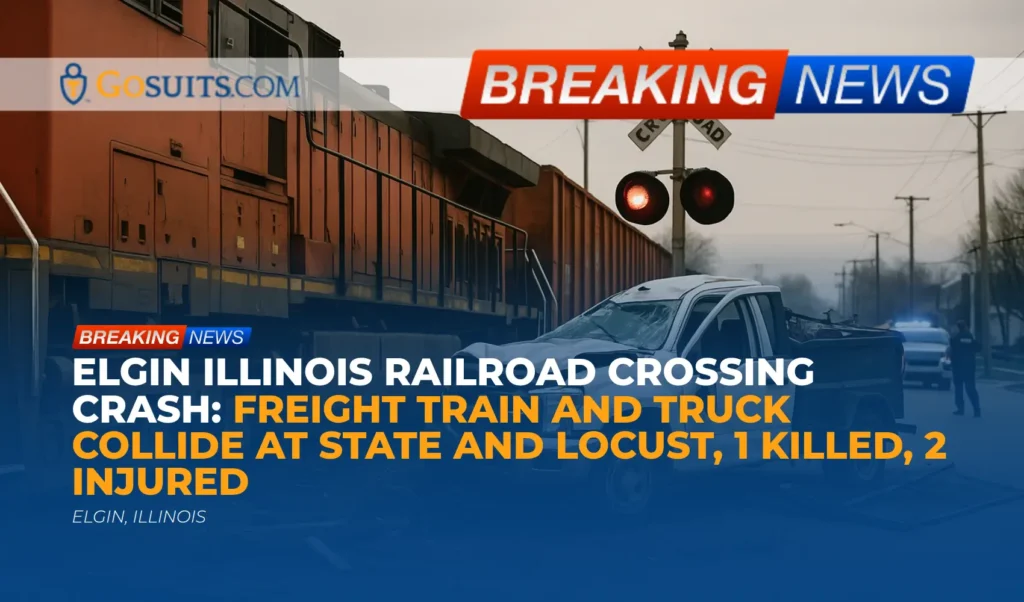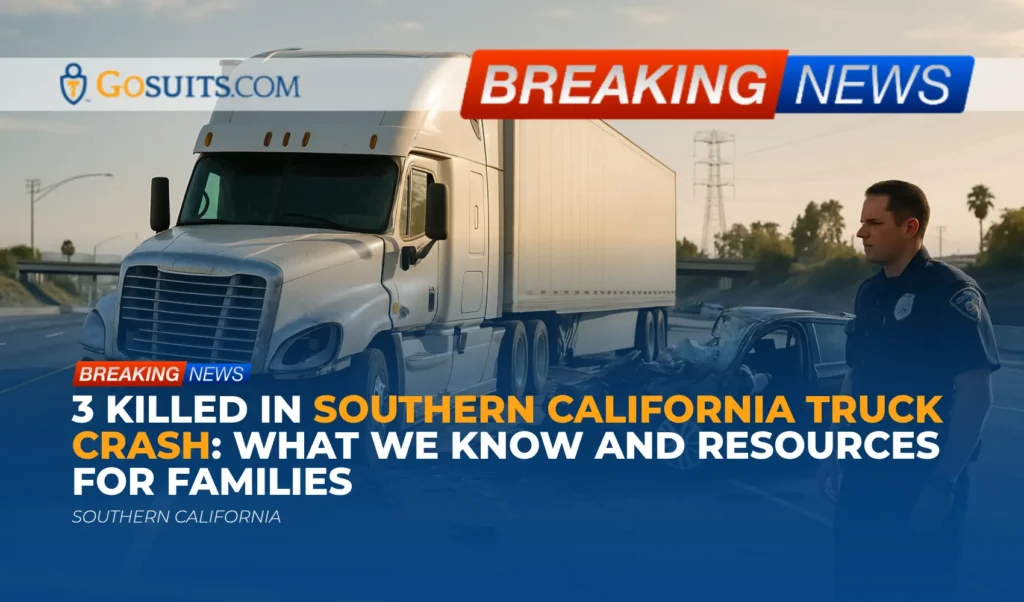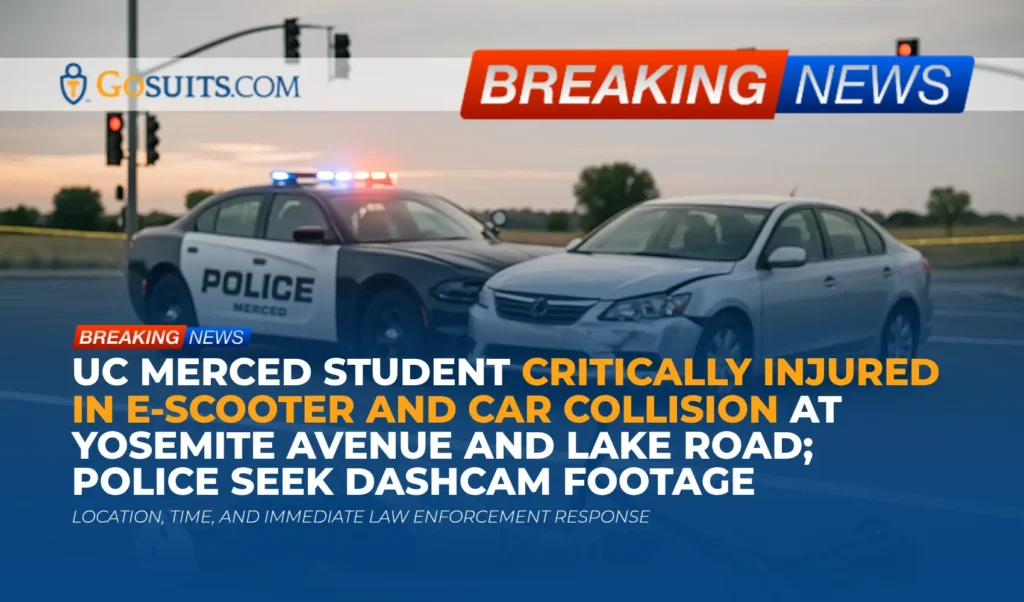- What We Know About the Monterey Road Pedestrian Fatality in San Jose
- Understanding California Pedestrian Right-of-Way and Duties
- How Fault Is Evaluated in Pedestrian Collisions
- Potential Civil Claims After a Fatal Pedestrian Crash
- Insurance Issues and Practical Steps
- Where to Get Official Records and Support in Santa Clara County
- Pedestrian Safety Context and Data
- What To Do Next: Acting Promptly Matters
- Commentary from Gosuits San Jose, California Personal Injury Attorney
What We Know About the Monterey Road Pedestrian Fatality in San Jose
San Jose police reported a fatal pedestrian collision early Thursday at approximately 5:59 a.m. on Monterey Road near Edenview Drive. According to the preliminary account, a man driving a silver 2001 Acura sedan was traveling northbound on Monterey Road and struck a man who was walking east across the roadway. The driver initially left the scene but returned shortly thereafter and has been cooperating with traffic investigators. The pedestrian was not in a marked crosswalk. The victim died at the scene. His name has not been released pending formal identification and notification of next of kin by the Santa Clara County Medical Examiner-Coroner’s Office. This incident was described by police as the city’s 30th roadway death this year and the 15th involving a pedestrian.
Police emphasized that state law no longer criminalizes jaywalking when a person can safely cross a roadway; however, as explained below, California law continues to impose duties on both drivers and pedestrians aimed at preventing crashes. The investigation remains ongoing, and authorities have asked anyone with information to contact the San Jose Police Department Traffic Investigations Unit.
Why location and time matter in early-morning roadway collisions
Collisions before sunrise can involve complex visual factors such as low ambient light, headlight glare, shadows, and driver fatigue. Investigators typically consider traffic speed, lighting, lane configuration, visibility, and whether there were nearby intersections or unmarked crosswalks. While the full details here will come from official reports, early morning timing and the characteristics of Monterey Road are the types of context investigators review.
How to share tips with investigators
Members of the public who saw the collision or have dash-camera footage often play a critical role in clarifying the sequence of events. The San Jose Police Department has requested that information be directed to its Traffic Investigations Unit. In addition to the contact provided by police for the assigned detective in this case, the department’s Records and general contact pages are available on the City of San Jose website at sanjoseca.gov.
Understanding California Pedestrian Right-of-Way and Duties
California law assigns responsibilities to both drivers and pedestrians. The details below are general legal principles that often guide collision investigations and civil claims after a crash.
Drivers’ duty to yield at crosswalks
Under California Vehicle Code section 21950, drivers must yield the right-of-way to pedestrians crossing within any marked crosswalk or within an unmarked crosswalk at an intersection. At the same time, pedestrians must not suddenly leave a curb or place of safety and walk or run into the path of a vehicle so close as to constitute an immediate hazard. The statute also requires drivers to exercise all due care for the safety of a pedestrian, including reducing speed when necessary. See CVC § 21950.
Pedestrians crossing outside a crosswalk
When a pedestrian crosses at a location other than a crosswalk or at a place other than within an unmarked crosswalk at an intersection, California Vehicle Code section 21954 provides that the pedestrian must yield the right-of-way to vehicles close enough to pose an immediate hazard. Importantly, this statute also preserves the driver’s obligation to exercise due care for pedestrian safety. See CVC § 21954.
Marked and unmarked crosswalks
Many Californians are surprised to learn that most intersections, even if there are no painted lines, include unmarked crosswalks connecting the sidewalks. California law treats those unmarked crosswalks similarly to marked ones for purposes of yielding duties and right-of-way. The California Driver Handbook reinforces these concepts for both drivers and pedestrians; see the state’s guidance at the Department of Motor Vehicles: DMV Driver Handbook – Pedestrians.
Jaywalking enforcement context
California’s “Freedom to Walk” legislation changed how jaywalking laws are enforced, directing that citations for crossing outside a crosswalk generally be limited to situations posing an immediate hazard. The text and history of this change can be reviewed on the California Legislature’s official site at AB 2147 (2021–2022). Regardless of enforcement, civil fault after a collision is evaluated under negligence rules that weigh the conduct of all involved and the totality of circumstances.
How Fault Is Evaluated in Pedestrian Collisions
Determining civil responsibility after a pedestrian crash involves careful evidence gathering and application of California’s negligence and comparative fault principles.
Evidence typically reviewed
Investigators and reconstruction professionals often assess:
- Scene evidence such as tire marks, debris field, lane position, and final rest positions.
- Lighting and visibility including street lighting, headlight use, weather, and sightlines.
- Speeds and stopping distance analyzed through vehicle data, roadway measurements, and physics models.
- Driver factors including attention, distraction, fatigue, and potential impairment.
- Pedestrian factors including point of crossing, direction of travel, and conspicuity (clothing, reflectivity).
- Digital evidence from dash cameras, nearby businesses’ surveillance systems, and vehicle event data recorders when available.
- Witness statements and timing consistency across accounts.
This evidence helps clarify how the collision happened and whether any party failed to use reasonable care under the circumstances, which is the core standard for negligence in California.
California’s negligence and comparative fault rules
California Civil Code section 1714 establishes that everyone is responsible for injuries caused by their lack of ordinary care in managing their person or property. See Civ. Code § 1714(a). California follows a “pure” comparative negligence system, meaning a judge or jury can assign percentages of fault to each party, and a claimant’s recovery may be reduced by their percentage of fault rather than barred entirely. This doctrine was adopted by the California Supreme Court in Li v. Yellow Cab Co. (1975) (Stanford Law School SCOCAL).
In pedestrian cases, it is common for liability assessments to consider whether the driver maintained a safe speed, kept a proper lookout, and exercised due care; and whether the pedestrian crossed in a way that created or did not create an immediate hazard. Even when a pedestrian crosses outside a marked crosswalk, drivers still have an independent duty to use reasonable care to avoid collisions.
Potential Civil Claims After a Fatal Pedestrian Crash
When a pedestrian is killed, California law allows certain family members or a representative to bring civil claims seeking accountability for losses. Every case depends on its own facts and evidence, and the information below is general in nature.
Wrongful death
California’s wrongful death statute allows specified survivors to seek damages for losses such as the value of financial support, household services, and non-economic loss of companionship. The statute identifies who may bring a claim and in what order. See Code of Civil Procedure § 377.60.
Survival action
A survival action is brought by the decedent’s personal representative or successor-in-interest and allows recovery for certain losses the decedent sustained before death. See Code of Civil Procedure § 377.30.
Deadlines
In California, most wrongful death and personal injury claims must be filed within two years of the date of injury or death. See Code of Civil Procedure § 335.1. Shorter deadlines apply if a public entity might be responsible for a dangerous condition of public property (for example, alleged roadway design, inadequate lighting, or lack of traffic control devices). In those cases, a written government claim usually must be presented within six months of the incident. See Gov. Code § 911.2. Substantive liability rules for dangerous conditions appear in Gov. Code § 835.
Because deadlines can be unforgiving, early evaluation is important to determine which legal time limits apply, what notices must be sent, and what evidence needs to be preserved.
Insurance Issues and Practical Steps
Insurance coverage is often multifaceted after a pedestrian fatality. Families may need to navigate several policies and claim types while also protecting their rights.

Common coverages that may be relevant
- At-fault driver’s liability insurance typically addresses bodily injury claims arising from the driver’s negligence.
- Uninsured/Underinsured Motorist (UM/UIM) coverage on the decedent’s own auto policy (or sometimes a resident relative’s policy) may apply if the at-fault driver lacks adequate limits.
- Medical payments (MedPay) may provide limited benefits regardless of fault under certain policies for medical expenses incurred before death.
- Wrongful death and survival claims are asserted against the liable party or parties and are generally handled by their insurers.
Before talking to any insurer, get legal guidance
Insurers often request recorded statements and signed authorizations early on. It is prudent to speak with a seasoned attorney first, because what is said to an insurance company can be used later in ways that affect liability and damages evaluations. An initial consultation can help clarify what to say, what not to say, and how to structure communications to avoid misunderstandings.
Preserving critical evidence
Important evidence can be lost quickly, especially traffic camera loops, nearby business footage, vehicle event data, and skid or debris patterns at the scene. Steps that are often helpful include:
- Sending preservation letters to involved insurers, potential public entities, and nearby businesses asking them to retain relevant video and records.
- Documenting the scene promptly through photographs and measurements, if safe and permitted.
- Identifying witnesses and keeping their contact details current for investigators.
- Securing the decedent’s personal items such as clothing, phone, and bag, as these can sometimes assist reconstruction.
- Requesting official records (collision reports, coroner reports) as soon as they become available, as described below.
Where to Get Official Records and Support in Santa Clara County
Official records provide objective documentation of key facts. Access procedures and timing vary by agency. Below are common sources related to a fatal pedestrian crash in San Jose.
San Jose Police Department collision report
The SJPD Traffic Investigations Unit prepares a collision report that may include diagrams, measurements, vehicle and pedestrian paths, and witness statements. Report availability depends on the status of the investigation. Information on requesting police reports and contacting the Records Unit is available on the City of San Jose’s official site at Police Department – Records Division.
If investigators have asked for public tips, those can be provided using the contact information they shared. For general departmental resources, see San Jose Police Department.
Santa Clara County Medical Examiner-Coroner
The Medical Examiner-Coroner provides official identification, determines cause and manner of death, and maintains related records. Next of kin may obtain information about autopsy and toxicology reports, personal property release, and the process for obtaining copies. Visit the county’s official Medical Examiner site at medicalexaminer.sccgov.org for guidance on requests and family resources.
Death certificates
Certified death certificates are issued by the Santa Clara County Clerk-Recorder’s Office. These records are often needed for insurance claims, estate matters, and other administrative processes. Instructions and eligibility requirements appear at the county’s site: Santa Clara County Death Certificates.
California Victim Compensation Board (CalVCB)
Families may be eligible for assistance with certain crime-related expenses, including funeral and burial costs and mental health counseling, when statutory criteria are met. Program details, covered expenses, and application instructions are provided by the California Victim Compensation Board at victims.ca.gov.
Sharing information with investigators
Witnesses or community members with relevant information can help SJPD resolve unanswered questions. In addition to the department’s general contact options, investigators sometimes list a direct phone number and email for the assigned detective during active investigations. When communicating, be as specific as possible about time, direction of travel, lane positions, and any distinguishing details observed.
Pedestrian Safety Context and Data
Data can provide useful perspective on how and why pedestrian fatalities occur and where prevention efforts are most needed.
National context
According to the National Highway Traffic Safety Administration (NHTSA), pedestrians remain among the most vulnerable road users, with thousands killed and tens of thousands injured annually nationwide. NHTSA emphasizes driver attentiveness, speed management, and pedestrian visibility as key risk factors. See NHTSA – Pedestrian Safety.
California trends
The California Office of Traffic Safety (OTS) reports persistent concerns with pedestrian fatalities across the state. OTS highlights strategies such as lower speeds in high-injury corridors, improved lighting, and better crossing infrastructure. See OTS – Pedestrian Safety Facts.

Local efforts
San Jose’s comprehensive traffic safety initiatives aim to prevent serious and fatal crashes, particularly in corridors with a history of severe injuries. The city publishes information about its safety programs and project updates, including pedestrian safety improvements, on its official website at San Jose Vision Zero. Roadway safety work often focuses on speed reduction, improved crosswalk visibility, lighting, median refuges, and targeted enforcement in high-injury networks.
It is important to remember that infrastructure, behavior, and enforcement each play a role. Even a single design change, such as adding a high-visibility crosswalk or adjusting signal timing, can significantly affect crash patterns, while driver and pedestrian choices remain crucial every day.
What To Do Next: Acting Promptly Matters
The period immediately following a fatal traffic collision is emotionally overwhelming, and the practical steps can feel daunting. Acting in a timely and organized way helps protect legal rights and preserves important evidence.
- Clarify agency points of contact so updates are received consistently. Keep a log of who is contacted and when.
- Gather documents such as any preliminary incident numbers, property receipts, and information provided by responding officers.
- Preserve digital evidence by requesting nearby businesses and residents retain video during the dates and times of interest.
- Secure personal items and maintain chain-of-custody notes for anything that might later be evidence.
- Note deadlines including potential two-year filing deadlines and the six-month government-claim deadline if a public entity may be implicated.
- Coordinate with insurers carefully and avoid recorded statements until a legal consultation provides clarity. What is said early on can have lasting consequences.
- Request official records as they become available, including the police collision report and, when appropriate, the coroner’s findings.
- Consider grief and counseling resources and evaluate whether CalVCB assistance may help with funeral or counseling costs.
Timeliness matters because video is overwritten, vehicles get repaired, witnesses become harder to locate, and statutory deadlines approach quickly. Taking structured steps early preserves options and supports a clearer understanding of what happened and why.
Commentary from Gosuits San Jose, California Personal Injury Attorney
Our thoughts are with the family and loved ones affected by the loss reported on Monterey Road. Sudden, unexpected loss on a familiar roadway leaves deep questions and profound grief. This commentary is intended for general information and education; it is not a substitute for legal advice tailored to any specific situation.
From a civil injury perspective, an investigation like this typically focuses on where and how the pedestrian was crossing, the driver’s speed and lookout, lighting and visibility at that hour, and whether any roadway characteristics contributed to risk. California law requires drivers to exercise due care for the safety of pedestrians, even outside marked crosswalks, and requires pedestrians crossing mid-block to yield to immediate hazards. These duties exist together, and the outcome often turns on careful, fact-specific analysis rather than any single factor.
In our experience, insurance carriers move quickly to limit exposure. Adjusters may request recorded statements, broad medical or records authorizations, or push for early resolutions before key facts are known. Corporations and insurers understand how to shape a record from day one, and they sometimes rely on the lack of familiarity most people have with fault allocation, comparative negligence, roadway design claims, and the evidentiary value of video or vehicle data. Without guidance, families can inadvertently say or sign something that narrows their rights or undervalues future harms and losses.
A free consultation provides a safe space to ask questions, understand potential claims and defenses, identify time-sensitive steps, and plan a path for preserving evidence. It also allows a family to hear how California’s comparative fault, wrongful death statutes, and government-claim rules could apply to their unique facts. Even if no further action is taken, that early clarity can prevent missteps and protect options while the investigation unfolds.
Key legal and public resources cited above
- California Vehicle Code § 21950 (drivers’ duties at crosswalks)
- California Vehicle Code § 21954 (pedestrians outside crosswalks)
- AB 2147 – Freedom to Walk (Legislature)
- Civil Code § 1714 (general negligence principle)
- Li v. Yellow Cab Co. (pure comparative negligence)
- Code of Civil Procedure § 377.60 (wrongful death)
- Code of Civil Procedure § 377.30 (survival action)
- Code of Civil Procedure § 335.1 (two-year statute of limitations)
- Gov. Code § 911.2 (government claim within six months)
- Gov. Code § 835 (dangerous condition of public property)
- California DMV – Pedestrians (Driver Handbook)
- NHTSA – Pedestrian Safety
- California OTS – Pedestrian Safety Facts
- San Jose Police Department – Records Division
- Santa Clara County Medical Examiner-Coroner
- Santa Clara County Death Certificates
- California Victim Compensation Board (CalVCB)
- City of San Jose – Vision Zero






